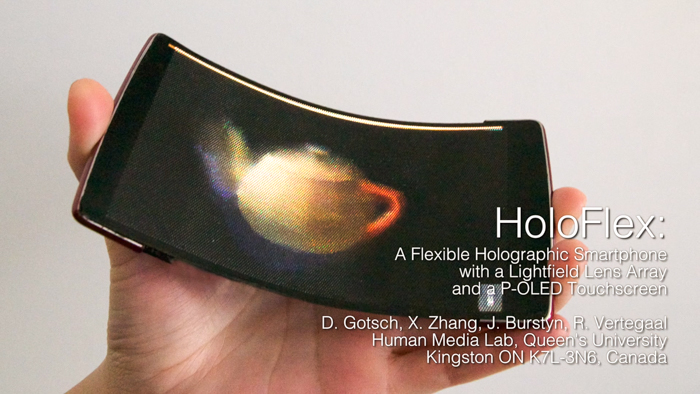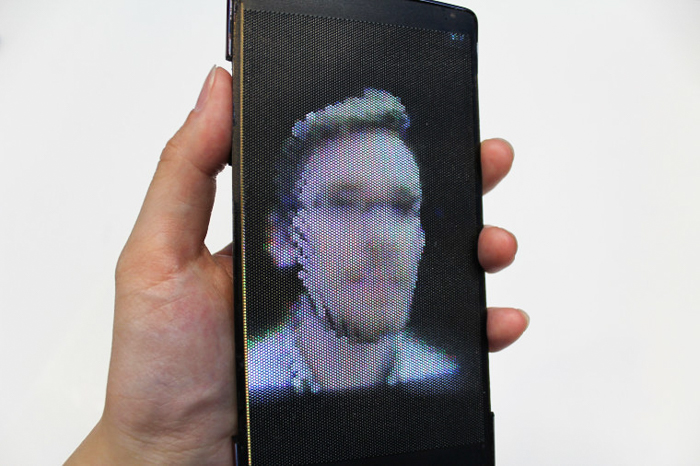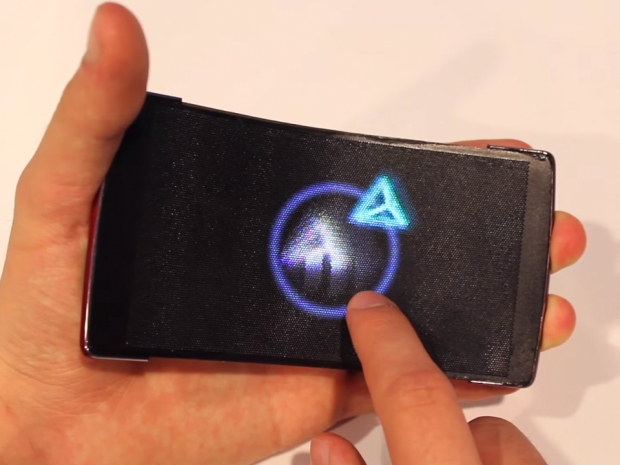
A flexible holographic smartphone with light-field lens array unveiled May 9th in San Jose, California
The Holoflex mobile device features a 1920x1080p Plastic Organic LED (P-OLED) display, the same kind featured in the LG G Watch R. The difference, however, is that this display features a matrix consisting of over 16,000 fisheye lenses. Images are rendered onto 12-pixel wide circular blocks that render a 3D object’s full view from a particular viewpoint. The dozen pixel blocks then project through the fisheye microlens array and produce a final 160x104 resolution image that let’s users see a 3D object from just about any angle simply by rotating the device.

The Holoflex uses a microlens light-field array consisting of 16,000 fish-eye lenses
In context, a microlens array splits rendered images into individual light rays, similar to the way a plenoptic camera or light field headset does on-board image rendering. The array captures information about light intensity in a scene and the direction of travel that light rays are heading. As a result, depth-of-field (DoF) information appears much more three-dimensional and allows multiple users to see stereoscopic images with motion parallax without any needed for glasses or head tracking.
The Human Media Lab research team says that X, Y input is controlled by touching the display, while Z-input is controlled by bending the display.
“HoloFlex offers a completely new way of interacting with your smartphone. It allows for glasses-free interactions with 3D video and images in a way that does not encumber the user.” says Dr. Vertegaal.
“By employing a depth camera, users can perform holographic video conferences with one another. When bending the display users literally pop out of the screen and can even look around each other, with their faces rendered correctly from any angle to any onlooker.”
The Media Lab team at Queens University has been busy inventing some pretty interesting devices over the past few months. In September 2015, a queens professor and his mentor partnered with Microsoft’s Applied Sciences Group to unveil DisplayCover, a tablet cover constructed from a thin-film e-ink display that dynamically adjusts display content based on usage context. During that same month, Queens professor Roel Vertegaal and three students introduced PrintPut, a conductive filament that allows resistive and capacitive pressure sensors to be placed on 3D-printed objects. In October 2015, Vertegaal and some of his students again unveiled BitDrones, an interactive swarm of flying voxels (3D pixels) that uses nano quad-copters as self-levitating tangible building blocks.
In February 2016, the professor and his students followed up with ReFlex, the “world’s first full-color, high-resolution wireless flexible smartphone” to combine multitouch with bend input. The device allows users to feel physical tactile feedback when bending the device – and playing games like Angry Birds with simple bend gestures. This device is based on a 720p LG flexible OLED display and is powered by an Android 4.4 “KitKat” board mounted to the side of the display.
This month, aside from Holoflex, one of the lab’s newest projects aside from is a new device with a cyclindrical display called MagicWand. The research group claims it is very similar to a Nintendo Wii remote, but with a 340-degree cylindrical display that uses visual perspective to create an illusion of motion parallax.
Funding and technology applications
The research project was supported by Immersion Canada Inc. and the Natural Science and Engineering Research Council of Canada (NSERC). Dr. Vertegaal from the Queen’s research lab says the device can be useful for bend gestures along the 3D input axis to facilitate the editing of three-dimensional models, including 3D-printed models. Other potential uses include holographic video conferencing and holographic gaming, among a growing list of novel situations.

